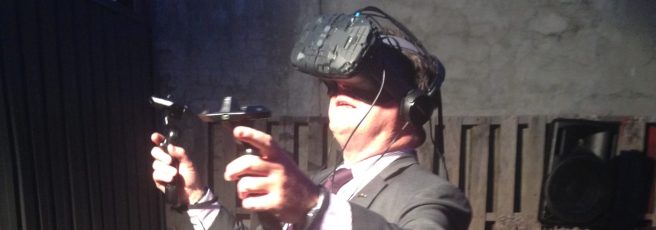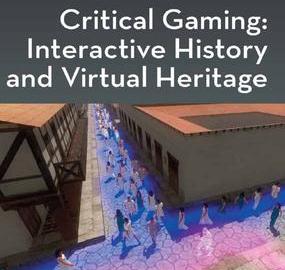Looking at my resume at long last I noticed I am so much busier for some journals than for others and review for others-quite a lot! Time to trim, scale down and maybe talk to a new journal. Ideas are only fresh for so long. I also notice most of the journals are not digital heritage-related and quite a few are not serious games-related!
In the last year or so have been asked to (blind) review for Computers & Graphics, Entertainment Computing, Nature, Digital Applications in Archaeology and Cultural Heritage, Journal on Computing and Cultural Heritage, Journal of Aesthetics & Culture, Journal of Archaeological Science: Reports (and book proposals for Routledge, MIT, Oxford..) and I am sure I missed quite a few..
Hmm, quite a few are Elsevier journals..hmm..
Program Committees, Conference Reviews & Journal Boards
Editorial Board member of
- The Journal of Computing Applications in Archaeology (I finish my term this month)
- Digital Creativity (been a reviewer for a decade I think? Review a lot for them)
- Games & Culture (not sure what happened there)
- Journal of Gaming and Virtual Worlds (still review occasionally for them)
- The Journal of Interactive Humanities (not sure what happened there)
- Studies in the Digital Humanities (not sure what happened there)
- Journal of Media Critiques (not sure what happened there, they are busy enough, probably don’t need me
- Editorial board member of new Explorations in Heritage Studies book series, Berghahn Books. URL: http://www.berghahnbooks.com/series.php?pg=expl_heri (but never asked to review books. Time to leave officially?)
- Invited Scientific Committee member Journal of Virtual Reality and Broadcasting (JVRB) (nice people, but not asked to review many articles).
WAS
- Loading editorial member (I recommend them, nice group of people)
- 2011-2018 Editorial board member, International Journal of People-Oriented Programming.
- International Journal of Architectural Computing (IJAC) editorial board for 2009-2014.
- Invited Scientific Committee of Virtual Heritage Network: Ireland.
- Invited Foundation member, China-Australia Writing Centre, Curtin University.
- Co-editor of special issue (“Games and Virtual Worlds for History and Heritage”) for Games and Culture, 2011.
- EU COST trans-domain application reviewer (2013-2015).
- Invited editor-in-chief of the 2010 CAADRIA special issue, International Journal of Architectural Computing (IJAC).
- Special Issue editor or co-editor of Techné: Real and Virtual Places, International Journal of Heritage Studies: Sense(s) of Place, Leonardo: Creative Data.
- Book/Book Chapter Reviewer: Oxford, Routledge, Bloomsbury, MIT Press, UNPE, and Springer.
- Past Book Review Co-editor of the International Journal of Gaming and Computer-Mediated Simulations (IJGCMS).
Member of
- CIC-The Curtin Institute for Computation, Programme Leader of Visualisation, http://computation.curtin.edu.au/ and on the Steering Committee. [Will leave in September]
- ICOMOS-International Council on Monuments and Sites (New Zealand branch) and Was ICIP (ICOMOS International Committee on Interpretation and Presentation of Cultural Heritage Sites) member, think they left me off the list. Time to leave ICOMOS?
- VSMM-On the Board of Directors, Virtual Systems and Multimedia Society (http://vsmm.org/about/leadership/).
- Explore-AT International Steering Committee. ExploreAT! Exploring Austria’s culture through the language glass is a 751,000€ European research project. (1.4.2015-31.3.2019). Hmm, finished!
- ARC Indigenous Discovery Advisory Group member: https://news.curtin.edu.au/media-releases/new-biodiversity-research-project-aims-to-heal-land-and-people/ Healing Land, Healing People: Novel Nyungar Perspectives, a 5 year project led by Mr Darryl Kickett (2020-2025).
- 2020 European Architectural History Network member.
- Past (invited) member of Virtual Heritage Network’s Scientific committee, Ireland (http://www.vhnireland.org/).
- Ex-AAPI Australia Asia Pacific Institute, Curtin University (2014-2018, the year of its closure).
- Ex ACM member.
Past history (ongoing and one-off reviews)
2021 Invited committee member, Australian Museums & Galleries Association (AMaGA) National Conference (Perth).
2020 Reviewed for Digital Humanities 2020, CAA2020. Reviewer for Journal of Aesthetics and Culture and Computers & Graphics Journal.
2019 Invited reviewer: ISEA-International Symposium on Electronic Art (South Korea); CAA (Computer Applications and Quantitative Methods in Archaeology) (Krakow); CAADRIA 2019 (New Zealand); ILRN -Immersive Learning Research Network (London); ACM SIGGRAPH International Conference on Virtual Reality Continuum and Its Applications in Industry (VRCAI 2019); International Conference on Entertainment Computing and Joint Conference on Serious Games; The Fourth International Conference on Economic and Business Management (FEBM2019) (China), http://www.febm.org/.
Invited journal article reviewer for International Journal of Heritage Studies; invited external reviewer for New Frontiers in Research Fund (NFRF), Canada; reviewed Australian Research Council (ARC) applications.
2018 Invited reviewer: Digital Heritage 2018 (San Francisco), ICADL-International Conference on Asia-Pacific Digital Libraries (Hamilton), ISEA-International Symposium on Electronic Art (Durban), Web3D ’18 (Poznań), eHeritage (Brasov). Invited reviewer: Journal of Cultural Heritage, Journal on Computing and Cultural Heritage.
2017 Invited reviewer for Journal of Archaeological Science. Invited respondent for Current Anthropology (“3D Virtual Replicas and Simulations of the Past: ‘Real’ or ‘Fake’ Representations?” by Fabrizio Galeazzi). Reviewer for DiGRA2017 (Melbourne).
Local Programme Committee co-chair www2017 (Perth), ISEA 2017 (Columbia), CAA2017 (Atlanta) track director, CAADRIA (China), eCAADE2017 (Rome), web3D 2017 tutorials co-chair conference (Brisbane), iLRN2017 (Coimbra), local organizing committee co-Chair, www2017 (Perth), ILRN 2017, Portugal.
2016 ILRN reviewer. Board of Reviewers for CAA (Computer Applications and Quantitative Methods in Archaeology). CAADRIA 2016 reviewer. Programme Committee and Local Organizing Committee for JCSG 2016: Joint Conference on Serious Games 2016, Brisbane 26-27 September 2016. Reviewer: DiGRA 2016. Invited Committee member, CAADRIA 2016 Melbourne, Web3D 2016 Los Angeles, USA and TEEM 2016, Salamanca Spain (also as Scientific Committee member).
Invited book submission reviewer, University Press of New England (UNPE). JCSG 2016 (7th Serious Games Development & Applications (SGDA 2016) and 6th GameDays 2016) conference, Brisbane.
2015 Board of Reviewers for CAA. Reviewed for Slactions 2015, ILRN 2015 International Co-Chair Asia Pacific. ECGBL2015. Invited committee member, VIRTUAL ARCHAEOLOGY: Museums & Cultural Tourism (VAMCT: Delphi, Greece) and Digital Heritage 2015 (Granada, Spain), Electronic Visualisation and the Arts Australasia 2015 (EVAA 2016: Canberra, Australia), and CHINZ2015: New Zealand Conference on Human-Computer Interaction (Waikato, NZ), Virtual Heritage Network (VHN) Ireland conference.
2014 On editorial board of DiRT (Digital Research Tools) wiki: http://dirt.projectbamboo.org/about.
Invited reviewer for Journal of Cultural Heritage and Computing, ECGBL 2014, CHi2014, ICEC Entertainment Computing 2014, and CAADRIA 2014 Postgraduate Committee. On the committee of Digital Humanities Australia 2014. Invited reviewer for Architectural Design Research Symposium, 20-21 November 2014, Venice. http://www.victoria.ac.nz/fad/research/architectural-research-through-design
2013 Invited conference reviewer for ACM CHI2013: Changing Perspectives, CAADRIA 2013 (and proceedings), ACM Creativity and Cognition 2013 and Slactions 2013. Book proposal reviewer for Routledge. Invited book reviewer for Understanding Machinima (MIT Press), and Heritage and Society (journal).
2012 Invited conference reviewer for the International Symposium on Mixed and Augmented Reality (ISMAR 2012). Invited by the ICOMOS ICIP chair onto the Program Committee of High-Tech Heritage: How Are Digital Technologies Changing Our Views of the Past? Conference, May 2-4, 2012 Amherst, MA USA. (http://www.umass.edu/chs/news/conference2012.html). Invited conference reviewer for Digital Humanities 2012 and IHCI 2012(declined), CAADRIA 2012. Invited conference reviewer for CHINZ 2012, VSMM2012, OZCHi2012, Creativity & Cognition 2012.
2011 Program committee member, 39th Annual Conference of Computer Applications and Quantitative Methods in Archaeology (CAA2011), Beijing, and CAAD Futures 2011, Belgium, Annual ACM SIGCHI NZ Conference on Computer-Human Interaction (CHINZ 2011), Waikato NZ, Creativity and Cognition 2011 (CC2011), United States, IADIS Interfaces and Human Computer Interaction 2011 (IHCI 2011), Rome.
Reviewer: ACM CHI Conference on Human Factors in Computing Systems CHI2011, Vancouver, Canada.
Invited book chapter reviewer for Alkhalifa, Eshaa and Gaid, Khulood, (Eds.). Cognitively Informed Interfaces, IGI Global Publishers, 2012.
Program committee member, IADIS Interfaces and Human Computer Interaction 2011.
2010 Invited onto the editorial board of International Journal of People-Oriented Programming.
Co-Programme chair of Computer Human-Interaction New Zealand (CHINZ 2010) in Auckland. Programme Chair Interactive Entertainment 2010 (ie2010), Wellington. Invited Scientific Committee member, 11th VAST International Symposium on Virtual Reality, Archaeology and Cultural Heritage, Paris, and European Computer Game-Based Learning (ECGBL 2010), Copenhagen and Digital Media and its Applications in Cultural Heritage 2010 (DMACH), Jordan. Committee member, Interactive Entertainment 2010 (ie2010), New Zealand. Invited paper reviewer, special issue “Graphics for Cultural Heritage”, Computers & Graphics (Elsevier).
2009 Invited to be editor of special issue of International Journal of Architectural Computing (IJAC). Invited as Committee reviewer for Virtual Systems and Multimedia (VSMM 2009), Vienna and for European Computer Game-Based Learning (ECGBL 2009), Austria. Invited Programme Committee and Conference Reviewer, (CAADRIA 2009), Taiwan. Invited onto Scientific Committee, International Journal of Virtual Reality and Broadcasting. Committee member, 10th VAST International Symposium on Virtual Reality, Archeology and Cultural Heritage, Malta.
2008 Invited onto the Best Presentation Award Committee at CAADRIA 2008 in Chiang Mai. Invited onto the editorial board of Games & Culture: A Journal of Interactive Media (Sage Journal) and International Journal of Gaming and Computer-Mediated Simulations. Invited technical committee member for Digital Media and its Applications in Cultural Heritage 2008 (DMACH), Jordan; for Interactive Entertainment 2008 (IE2008), Brisbane; and committee member, Australasian Computer-Human Interaction Conference 2008 (OZCHI), Townsville. Conference paper reviewer, ECGBL 2008.
2007 Invited co-editor for Leonardo Special Issue, MIT Press, and for The International Journal of Heritage Studies. Special issue editor of Techné (2007). On the editorial board of Loading…: The Journal of the Canadian Games Studies Association. Reviewer for The Journal of Virtual Reality and Broadcasting (JVRB), as well as Digital Humanities Quarterly. Invited book proposal reviewer for Routledge. Invited program committee member for OZCHI 2007 Adelaide, Creativity and Cognition 2007 Washington DC, DIMEA 2007 Perth, VSMM 2007 Sydney, Interactive Entertainment (IE2007) Melbourne. Program Committee member, ECGBL 2007: The European Conference on Games Based Learning, Scotland. Invited paper reviewer for DiGRA Situated Play conference, (Digital Games Research Association) Japan, and INTERACT 2007 Conference-Socially Responsible Interaction, Brazil.
2006 Invited panellist for Gaming and Education panel, Greater Brisbane Chapter, IGDA, International Game Developers Association, Sunday, 5 November 2006, http://www.igda.org/brisbane/education_report.html Invited program committee member /reviewer for Digital Interactive Media Entertainment & Arts (DIME 2006) Thailand, OzCHI2006 Sydney; VSMM 2006 China; Interactive Entertainment 2006, New Media and Heritage conference 2006 Hong Kong, SAHANZ 2006, Perth. Paper reviewer for Virtual Reality Journal (Springer). Invited external reviewer for Master’s Thesis examination, Creative Arts, RMIT.
2005 Invited Panellist for VSMM 2005. Journal and chapter reviewer for Enhancing Learning Through Technology (2006), Encyclopedia of Virtual Communities and Technologies (2005), Theorizing Digital Cultural Heritage (2007). Invited program committee member for International Conference on Virtual Storytelling 2005 conference, France; OzChi2005 conference, Canberra, Interaction Entertainment 2005 Conference, UTS, Sydney. Programme Committee member VSMM2005, Belgium.










